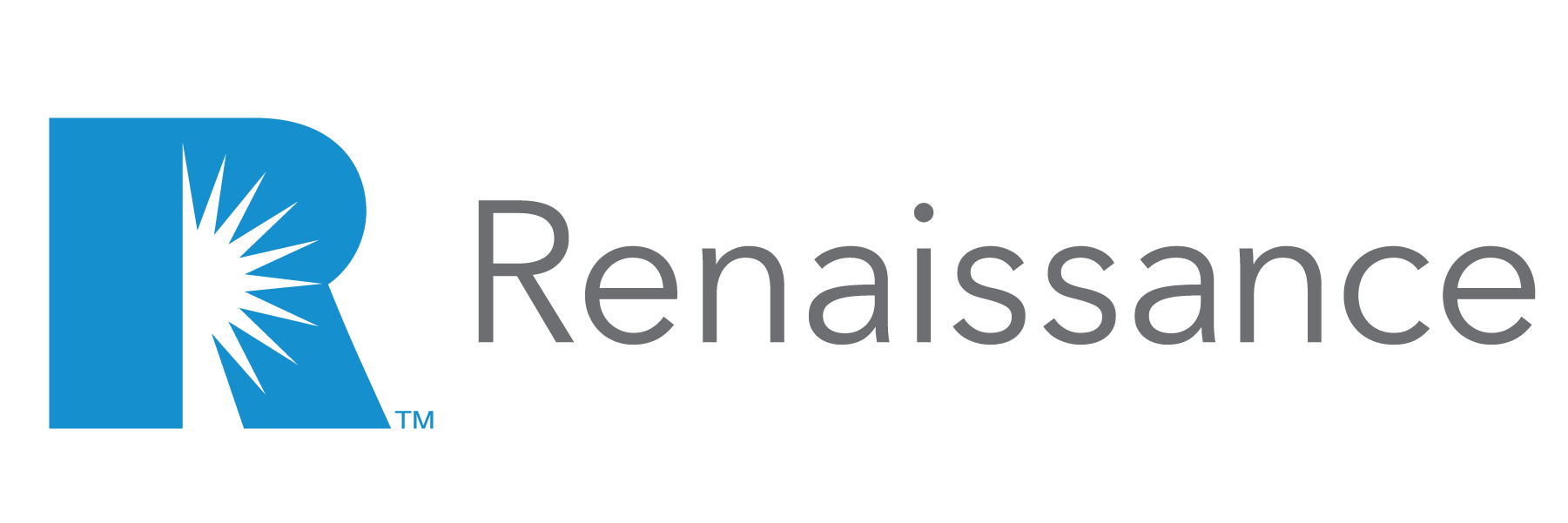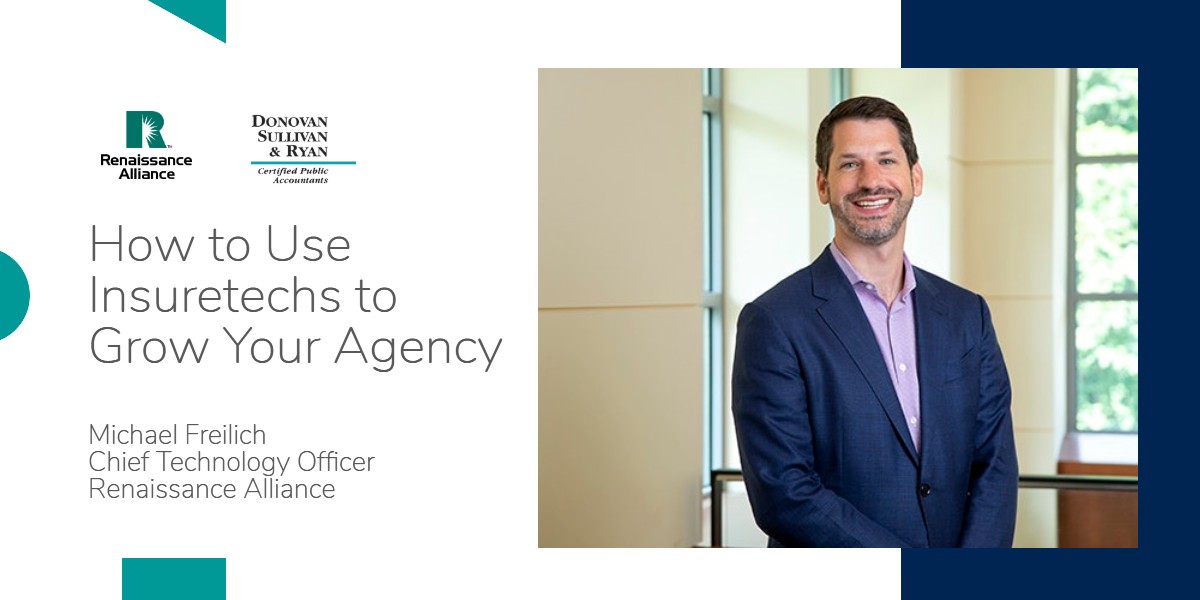Renaissance Chief Technology Officer Michael Freilich talks about how Insuretechs can benefit your insurance agency in a 55-minute webinar co-sponsored by Donovan Sullivan & Ryan. We offer both video and transcript versions of his recent webinar that offered an overview of his take on promising developments and companies specifically around services to benefit the independent insurance agency.
How to Use Insuretechs to Grow Your Insurance Agency – Renaissance Alliance – May 12, 2020 from Renaissance Alliance on Vimeo.
(Transcript) How to Use Insuretechs to Grow Your Insurance Agency
This 55 minute webinar opens with an introductory remarks by Leanne Ross and closes with a Q&A period. This transcripe encompasses the remarks by Michael Freilich, Chief Technology Officer of Renaissance Alliance. We thank our co-sponsored, Donovan Sullivan & Ryan.
It’s a pleasure to have you all with us this morning to talk about a pretty fun topic, the InsureTech world. Part of my job at Renaissance, of course, the whole thing is about bringing new tech to independent agencies. We do that by building software, being the custodian of the data and playing that back to our members in a way we think is compelling and will create growth. I’m also responsible for building partnerships. Partnerships with the latest tech out there that we think can create growth in the independent agency channel. And so, I talk to a couple of InsureTechs just about every week, and I hope to bring that background and that experience to you today.
I’m going to start by giving a little context, perhaps some perceptions around technology from where I sit, technology and the independent agent from where I sit. I’ll talk about InsureTech sort of broadly and what’s driving the InsureTech sort of phenomenon, if you will. And then I’m going to talk about some specific areas that I think are interesting in this space. I’m going to talk about commercial lines rating space, I’m going to talk about some data focused companies and companies that are focused on customer outreach.
Independent Agencies & Technology
I hope that what you get out of this is a sense of what’s good, how to look for what’s good, how to engage with the InsureTech ecosystem, and how to decide what to do in this space and how to be successful. And so with that, I will begin by just setting context around the independent agency channel and technology.
And I think that it’s fair to say that independent agents and technology are not best friends. This is a place where it can be confusing, it can be overwhelming, there’s tons of choices. When it doesn’t work, of course, it’s extremely frustrating and it’s expensive. And we all know that there is tons of innovation going on in technology everywhere, but specifically in insurance. But when you look at what is going on inside an independent agency’s office, you don’t necessarily see a reflection of that, of what we see every day outside of that world.
In some ways, I would say that that innovation that’s going on can be inaccessible to the typical independent agent. And so why is this? Well, there are a few reasons. One is that the tools that an independent agency has at their disposal are extremely powerful, they’re extremely flexible, but they’re complicated. This I’m sort of referring to the big management system players. These are technologies that were built over a long period of time, often connecting disparate parts of technology, and that makes it hard for them to modernize quickly.
They were also built really as closed ecosystems, which is sort of the opposite of the way modern software really works, which is much more open. And we’ll talk a little bit about that later.
Strategic use of data. Software is what it is today because of how it uses data, right? Because of the data that it uses in the world and the data that it gathers as you use the application. All of that is coupled with great design to create an experience that is easy so that the software responds to you the way you want it to respond. This is a thing that most of insurance software can’t do. By the way, this is not true across the board, but when we think about the big legacy players that many agencies run on, this is part of the issue.
And then finally, I think true across the board in the independent agency channel is what I call platform fatigue. Agencies have many, many platforms certainly for the size of the typical agency. Let alone the management system, perhaps some marketing software, some financial software, there is another platform for every single carrier out there. And each of those platforms have their quirks, their nuances, their differences, and it creates a very complicated technology environment. Makes adoption of new tech very hard. Makes learning new tech hard.
So with all of this in mind, I spend as much time as I can talking to our agencies about technology. And in a recent conversation I had with one of our members, the following statement was made, and I’ll put it up here. “Advances in technology have worked against the efficiency of my operation.”
So when this comment was made on the phone call, I have to say that I was sort of floored actually. And I would say my shock gave way to a little bit of depression. This is just not the way that I think about technology. And generally, I think it’s not the way we think about technology advancement broadly. But in the context of the agency, I totally understand where this comes from, right? The sense that there’s innovation going on everywhere but not necessarily geared toward the agent.
Trends enabling Insuretech
I think that this is changing. Of course, this is what Renaissance has really focused on changing. And there are a few big sort of overarching trends I’ll say that I think are enabling this. The first is that data is becoming more fluid. It is much easier to pass data between applications in around the world. Microservices architectures and APIs and things like this make it very easy for systems to integrate sort of regardless of platform. This is creating the ability to really change the way insurance functions, in many ways. Whether it’s underwriting, whether it’s claims, or whether it’s just simply connecting different systems.
The next is that carriers are opening up. I think it’s fair to say that, a decade ago when carriers were approached about integrating or more broadly opening up their systems in one way or another, it was very often a hard, “No,” or at least a, “Yes,” with very substantial caveats. And this is changing. Carriers are opening up their systems. Their systems are maturing. You see carriers paying InsureTechs to write APIs for their systems. And part of the reason for this is because they’re getting something in return here, whether that’s access to new tech that they find attractive, whether it’s additional data that they can get as a result of opening up their systems or deal flow that comes out of these things when it’s easier to transact business. And so, there is a trend here with carriers being much more open to and available to integrating and opening up.
And the last trend, and I’ll talk a little bit more about this later, but InsureTech, there’s a segment of InsureTech that is talked about in terms of this direct to consumer play. Certainly some of the biggest names in InsureTech are that. But I would say over the last three, four years or so, a lot of these direct players have looked to the agent for distribution. After all, most PNC premium comes through an independent agent. And so, there is a shift that’s happening there. And essentially all of this is really good news for agencies. It makes the technology more accessible. And of course, with that, hopefully, there’s growth behind that.
I’m going to talk just broadly about the InsureTech ecosystem. I’m not going to put a bunch of numbers and slides up here, but I’ll talk about some themes that I think sort of run through this space. The first is, the capital, talent and creativity. I’m not going to put a slide that shows all the billions of dollars that have been invested in InsureTech over the years. There’s lots of places to see that stuff. I’ll just make the comment here that there is a lot of money flowing into this space. There is tech veterans that have now set their sights on the insurance industry and they are bringing all sorts of new ideas, new technologies, new application of old technologies, putting together really creative solutions. This is only good news. It pushes the industry to do things a little bit differently.
The other point I would say related to this is that InsureTech is about new ideas not disruption. And this is from my view, I think there are certainly companies that consider themselves disruptors. And perhaps you could make an argument for that in some of the consumer-facing places, but generally and certainly as it relates to the technology that’s being built with the agents in mind, this is just about new ideas, new design, in creating an interaction between the agent and the technology that is modern, that’s easy and intuitive.
The last thing I’ll talk about here just broadly, this comment of problem solving, there are companies out there that are trying to change the way the industry works. And there are companies out there that are trying to solve very specific problem. The companies that I’ll highlight today and the ones that I always find most attractive, are the ones that have a very specific problem they’re trying to solve.
I would say, after talking to a lot of InsureTech companies, it’s actually quite easy to very quickly understand whether or not a founder is talking to a venture capital investor or if that founder is talking to an agency owner that has real on the ground problems they’re trying to solve. I’m very focused on the ones that are trying to solve real specific problems because that’s where I think the most value can be created.
I’ll get into a few areas here. Before I do that, I want to just keep in mind, so these are the three buckets I’m going to talk about. So commercial lines rating, the strategic use of data, and customer engagement. And then I’m also going to focus on sort of what are the outcomes that can be achieved around each of these.
In the end… Some of you that have heard me talk before may recall that, I’m not a fan of technology for technology’s sake. Technology in itself actually doesn’t create growth, it’s a change in behavior that actually results in business growth. And so, the tech that I’ll talk about today, is tech that I think has an outcome that is real, that can increase revenue, that has the potential to create some real operational efficiency, allowing you as an agency owner to deploy resources differently, decrease expenses overall. I’ll talk about why each of these areas is important, a few examples of companies I think are interesting in this space, and then the outcomes.
A couple caveats before I get into the next section. One is that this is a huge space. InsureTech is huge and I am barely scratching the surface actually. Even in these three areas, I’m barely scratching the surface of what’s out there. So it’s important to note that.
The second point I want to make is that as it relates to InsureTech, there are a lot of good ideas, there are a lot of bad ideas in InsureTech. Not all of it is good. And so, some of what I hope to communicate when we talk about this is what actually makes a good idea in InsureTech and how can you parse that. And the last comment I’ll make is just that I don’t intend to endorse any of these companies. These are all quite young companies. It’s very hard to tell what will happen to a company, especially considering what’s happening to the economy right now. It’s hard to know what these companies will look like in a year or two. And so, it’s important to caveat that.
Insuretechs: Commercial Lines Rating
I will talk about some partnerships that we’re embarking on as we go through here. And so, let’s start with the first area. So commercial lines rating. So why is this interesting? Well, to me it’s some of the most interesting innovation going on. Some of these companies are changing the way underwriting happens. They’re using different sources of data to get to a price which can reduce the number of questions that are asked in the application. And there’s all sorts of interesting benefit that happens when you start with looking at underwriting or you look at the product architecture actually.
The second point is that what we’re seeing in commercial lines rating is actually some real industry level integration. Multiple carriers that are existing on the same platform that really streamline the way quoting and engagement with the carrier can be done. This creates real standardization. I think we’re just at the very beginning of that, it’s hard to say where that might go, but there certainly is some great applications of tech that are creating the standardization that I’ll talk about here.
And lastly, market transparency. So because it’s hard to get a quote or can be hard to get a quote in the commercial space, it can be hard to actually understand what the market is for a given risk. And some of these companies are beginning to change that. I should say that most of these companies operate in the small commercial space and some in the very small commercial space. But so, let’s get into it.
The first company I’m going to talk about is Semsee. So Semsee is a company that has built a single application for BOP workers’ comp and Commercial Auto, to integrate with multiple carriers. This dramatically reduces the time to quote because the information is only entered once and multiple quotes come back. Semsee is using API technology but also robotic process automation, which is actually a key point for the typical agency. The reason is because not all carriers are going to be able to build tech that can integrate with modern platforms, with modern APIs. And so, the ability to have this robotic process automation, which by the way, what that is, is essentially a robot taking the data and going to a carrier website to fill it out.
The reason that’s important is because not all of our trading partners will perhaps ever be able to build great APIs to integrate with modern tech. And so, this is part of the value. Renaissance is doing a partnership with Semsee, and that partnership is really, in our minds it enhances the value of Semsee further. And integration with the data warehouse that Renaissance operates, allows remarketing and renewals to happen on a more streamlined basis, it allows us to embed things from Semsee back into the Renaissance applications, onboarding becomes faster. So there’s all sorts of interesting benefits around that partnership. And we think this is an exciting, very exciting space.
The next company I’m going to highlight is very young one, Thimble. Thimble is a little bit off the beaten path. It is a episodic insurance. So they sell policies that range from anywhere from two hours to full-term. I think monthly right now is their sort of most common policy term. It’s underwritten on Markel paper, and it is extremely fast to get a quote. They are focused on very small commercial. Handyman, beauty salons, freelancers in many ways. It’s a very interesting market. They’ve built a really great tech. It’s also an example of a company that probably has their eyes set on a direct play, but actually is very interested in agency distribution.
And they have a compensation model that is worth looking into for certain segments. It’s applicable for certain segments of risk. Perhaps not the bread and butter of what an agency always goes after, but nonetheless, really interesting tech to highlight here.
Tarmika is another company in the New England area that is also focused similar to Semsee on this sort of comparative rating in the small commercial space. And then I wanted to highlight Attune as well. Attune is a company that was, I think, the brainchild way back from Brian Duperreault and is now part of the AIG.
Attune is really in this underwriting space. They’re using real data science to try to eliminate as many of the questions that they can for the BOP application. And to me, this idea of changing the product architecture in order to create a better experience, to me is what this sort of InsureTech is all about in some regards. Certainly, in the rating space.
Attune is also a great example of a company that I think at first was focused on the direct market, which now has really turned its attention quite significantly to the agency space. It’s interesting technology, and I think there’s a lot of value being brought to the industry from Attune.
What are the outcomes we’re talking about in this space? We’re talking about faster time to quote, we’re talking about being able to spend more time focused on the customer need, and being able to find better markets for risk. There’s plenty of anecdotes around these companies where same or better coverage for less premium is found. I think it’s also fair to say that these companies have their ear to the ground on… There’s more than just price when picking a carrier. And I think tech today is actually enabling some of these nuance around service and coverage levels and all of this to come to the forefront as well. So very, very interesting space.
Insuretechs: Strategic Use of Data
The next bit I’m going to talk about is strategic use of data. So why is this interesting? Well, there is more data available in the world today than ever before. And the use of public data curated for insurance, I think is some of the most interesting sort of innovation happening. Part of this is around acquiring data. So understanding the data around a risk, making sure that that data is true. There is, I wrote the dream of pre-fill.
I think it’s fair to say that my understanding at least from the carrier perspective is that, pre-filling an application with public data is actually still a dream. That generally, the data is not good enough yet or it’s not trusted yet, is also a way to say that. And so, while there is an aspiration to be able to streamline that pre-fill process, we’re not there yet.
The other point here, and I’ll highlight a company that’s focused in this area is around extraction of data. So taking a piece of paper and yanking out the important data out of it using optical character recognition or regular expressions and maybe some machine learning tossed in to actually really intelligently read a document and digitize the data so that then can be used in other forms. One of which would be to create a better customer experience to engage that data, better user experience.
So one of the companies here. The first one I’ll highlight is Terrene Labs. Terrene Labs is one of these companies that’s using publicly available data to better understand a risk. They’re working primarily in the small commercial space, they look at things like trying to understand if a restaurant is also a nightclub, trying to understand if a lunch spot also serves alcohol, if a landscaper also does roofing work. They try to use data on the web and elsewhere to get a better picture of a risk upfront. They also have done some really great work around NAICS Code identification, Class Code identification. A very interesting company focused on sort of insight.
Another company I’ll highlight is Attestiv. They’re a very young company, but they’ve done some really interesting things around data acquisition via mobile devices. Taking a picture of things and then extracting the data from that. Very young, but interesting and worth keeping an eye on.
The next company I’ll highlight is Weathercheck. There’s all sorts of companies doing aerial imaging, looking at Google Maps and trying to uncover underwriting data around that. These are interesting, really more for the carrier side, I think, than the agency side. Weathercheck has a great agency offering, which is all about helping an agent get engaged in the claims or really I should say potential claim. It’s about protection.
Weathercheck gives alerts when a storm is coming. But after the storm, they try to predict whether or not damage may have occurred at a given address or zip code. And so, what this allows, the reason I found it compelling was because it actually creates an outreach point for an agency and their customer base potentially to say, “We understand there may have been some damages. Is everything okay?” Just a way to reach out. It’s some pretty interesting technology and I think it creates a nice value prop for the agency.
And the last company I’ll highlight is probably a little bit less applicable in the distribution space, but I wanted to highlight Groundspeed. Because from what I’ve seen, they’ve done some of the best sort of data extraction work. They’ve solved the loss run problem. Being able to extract data out of the loss run and organize it, is a notoriously hard machine learning problem. And they’ve made a lot of advances there. So it’s a company worth I think keeping an eye on.
What are we talking about when we think about the strategic use of data? By the way, this is another area where I should be sure to state that there are so many companies doing interesting things in data. These are just the ones that I thought were a diverse group that are interesting, but there’s lots of them. And so, I’m happy to talk more about that if it makes sense.
These companies, this is all about better understanding of risk. Insight about a prospect customer, getting more accurate data faster part of the acquisition space. The other areas here, there’s a whole world of fraud detection, there’s a whole world of forms and how forms can be created and managed and filled out faster. So lots going on here. But this is a little bit of a taste of some interesting things in the data space.
Insuretechs: Customer Engagement
And then finally, I’ll talk about customer engagement. So this is sort of the world of CRM, customer relationship management. I get probably more emails from agencies asking about CRM than any other of these topics, and it’s a hard one. I and my colleagues at Renaissance, we all have scars on our back from horrible CRM implementations in our past. Why horrible? Well, the big players in this space are complicated pieces of software, they’re extremely powerful.
And the problem with CRM, customer relationship management, here is that these pieces of software are only as good as the data that gets put in them. And so, adoption is just critical and adoption is really hard especially in this space. And so, I’m actually not going to highlight any of these big companies, the Salesforce.coms and Microsoft Dynamics, et cetera. I actually don’t tend to recommend them for the typical agency. They’re expensive. They are, as I mentioned, hard to get adoption. And generally, they’re more powerful than what’s needed for the typical agency. But there are a few options that I’ll highlight here, that I think have a very close sort of connection to value.
The first one of those I’ll highlight is Agency Revolution. Agency Revolution is an automated marketing solution. They comb your book of business for opportunities to cross-sell or different types of marketing campaigns. You set up the email in your language and you can have this automated outreach capability. Can free up time for other things in the agency or just add to the customer touchpoints.
Renaissance is pursuing a partnership with Agency Revolution. We think that this kind of automated outreach is something that Renaissance can provide as a service to its agencies, to our agency members. And there’s a very close tie here to retention and to cross-sell in just increasing customer touchpoints generally.
Also I’ll highlight a company called AgencyZoom. AgencyZoom is probably more on the traditional sort of CRM side of things, but this is a company that was built by agents, for agents. It’s very much tailored towards how an agency operates. Has some good integrations that exist and that are in the works. And I think in some sense if you’re thinking about sort of more traditional CRM, AgencyZoom is an option to look at.
Another company I’ll highlight is Levitate. Levitate is sort of less in CRM and more kind of keep in touch. Allows an agency to keep track of touchpoints around a customer and proactively sort of reach out. It’s lightweight capabilities, so to me it sort of fits in with this… Avoids this kind of platform fatigue concept. But some very interesting tech there and a good group.
The other company I’ll highlight is a very young one called 20Miles. And 20Miles is focused on building workflows around prospects. And they sort of orchestrate the engagement process around different workflows and processes. To me it was just a different and quite a creative way of thinking about customer engagement. And so, I thought it would be worth highlighting here.
What are we talking about outcomes here? Again, this is an area where tech for tech’s sake is a big pitfall. Everyone should have a CRM, so let’s go get one. Again, the important thing is really to focus on how will this get to higher retention? How will this get to better cross-sell or lead generation or at least managing leads? Producer accountability. You can’t change what you can’t measure, as they say. And so, these kinds of systems give you the ability to do that.
The last point here I’ll make is that the benefit around these pieces of software come from the discipline in using them. I mentioned they’re only as good as the data that comes in. Well, there’s also process discipline that is required in order to get the benefit out of them. I might go as far as to say that, the technology here, as long as it’s a good decent piece of technology, doesn’t matter which one is less important than the discipline and process that an agency puts in place to adopt it and to use it and leverage it. That requires quite a bit of commitment and discipline and perhaps even an incentive at the producer level too, to make sure that these things get used.
Success factors
So these are the profiles, but just a couple more thoughts before we’ll open it up for questions here. Just a few points around how to engage. The first is if I haven’t driven home the point yet which is focus on the outcome. Actually when you’re thinking about looking at InsureTechs, start with the outcome you want to achieve and then work your way back from there and find a solution that for your agency will achieve that. That is certainly how we think about it at Renaissance as we look at this landscape of companies and where to engage. It’s always about, what is the outcome we think we can achieve here?
The next point, ask for a pilot. Usually a pilot will depend on the maturity of the company. So a company that’s got lots of funding and is in the news all the time, it’s sort of less likely perhaps to do a pilot. Younger companies are more inclined because they want the user feedback, they want users and engagement. And of course, it’s also an indication of sort of the stock that the people that are there put in the company. If a company is open to doing a pilot it’s because they think once you get your hands on it, you won’t want to let go, and that’s a great sign.
Next point, I’ll say is to make time. If you’re going to embark on this journey and engage with some InsureTechs, make time to actually use the capability and explore it. It doesn’t help anyone involved to do a pilot or purchase a piece of software and then not use it. From the agency’s perspective, it’s important to make time when you commit to a new capability because it’s the only way that you’ll actually make sure that you understand it and get something out of it.
And the last point I’ll just say is growth. This is what we’re focused on. At Renaissance is what you should be thinking about when you think about the InsureTech spaces, is how can these companies help me grow? How can they help me make decisions that are a little bit different that will result in a higher retention cross-sell or new customers?
Insuretech Resources
Willis Towers Watson Quarterly InsureTech Briefing
Accenture Insurance Influencers podcast
Vertafore Podcast with Rick Fox
Insurance Innovators Podcast with Abel Travis
Connect with us
Michael Freilich, Chief Technology Officer – Connect with Michael on LinkedIn and Twitter
Leanne P. Ross, CIC, CRM, Senior Vice President, Agency Recruitment – Connect with Leanne on LinkedIn and Twitter.
Webinar cosponsor: Chris Ryan, CPA/MST, Partner, Donovan Sullivan & Ryan. Connect with Chris.






